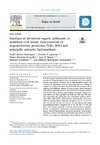Please use this identifier to cite or link to this item:
https://accedacris.ulpgc.es/jspui/handle/10553/59987
| Title: | Database of persistent organic pollutants in umbilical cord blood: Concentration of organochlorine pesticides, PCBs, BDEs and polycyclic aromatic hydrocarbons | Authors: | Cabrera-Rodríguez, Raúl Luzardo, Octavio P. Almeida-González, Maira Boada, Luis D. Zumbado, Manuel Henríquez-Hernández, Luis Alberto |
UNESCO Clasification: | 3214 Toxicología | Keywords: | Persistent organic pollutant Organochlorine pesticides Polychlorinated biphenyls Bromodiphenyl ethers Polycyclic aromatic hydrocarbons, et al |
Issue Date: | 2020 | Journal: | Data in Brief | Abstract: | Persistent organic pollutants (POPs) have been banned over the last decades for being damaged to the environment and to the health of humans and animals. However, due to their lipophilic nature and resistance to degradation, they are frequently detected in biological samples. Its presence has been associated with the increased risk of suffering from different diseases in human series, being newborns and children especially sensitive. The present data reports umbilical cord blood levels of twenty organochlorine pesticides (aldrin, dieldrin, endrin, o,p'-DDD, p,p'-DDD, o,p'-DDE, p,p'-DDE, o,p'-DDT, p,p'-DDT, endosulfan alfa, endosulfan beta, endosulfan sulphate, heptachlor, HCB, αHCH, βHCH, δHCH, lindane, methoxychlor and mirex), eighteen polychlorinated biphenyls (congeners 28, 52, 77, 81, 101, 105, 114, 118, 123, 126, 138, 153, 156, 157, 167, 169, 180 and 189), eight bromodiphenyl ethers (congeners 28, 47, 85, 99, 100, 153, 154 and 183), and sixteen polycyclic aromatic hydrocarbons (acenaphthalene, acenaphthene, anthracene, benzo(a)anthracene, benzo(a)pyrene, benzo(b)fluoranthene, benzo(g,h,i)perylene, benzo(k)fluoranthene, chrysene, dibenzo(a,h)anthracene, fluoranthene, fluorine, indene(1,2,3-cd)pyrene, naphthalene, phenanthrene and pyrene). A total of 447 samples, representing 86.6% of the total births during the recruited period (March 1, 2015, to April 30, 2016), were available for POP analyses. POPs were determined in a Gas Chromatography (GC) system equipped with an automated sampler (Models 7890B and 7693; Agilent Technologies, Palo Alto, CA, USA) for gas chromatographic separations. The detection of the analytes was performed using a Triple Quad 7010 mass spectrometer (Agilent Technologies). All of the measurements were performed as triplicate measurements, and the means were used for the calculations. Data are reported in ng/mL. The present data also includes birth parameters, including weight, length, cranial perimeter, Apgar score and congenital malformations, and data referred to mothers (harmful habits, chronic diseases, and anthropometric/demographic characteristics). | URI: | https://accedacris.ulpgc.es/handle/10553/59987 | ISSN: | 2352-3409 | DOI: | 10.1016/j.dib.2019.104918 | Source: | Data in Brief [ISSN 2352-3409], v. 28 (104918) |
| Appears in Collections: | Reseña |
SCOPUSTM
Citations
6
checked on Jun 8, 2025
WEB OF SCIENCETM
Citations
4
checked on Jun 8, 2025
Page view(s)
289
checked on Feb 22, 2025
Download(s)
206
checked on Feb 22, 2025
Google ScholarTM
Check
Altmetric
Share
Export metadata
Items in accedaCRIS are protected by copyright, with all rights reserved, unless otherwise indicated.
